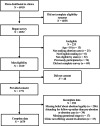Understanding abortion legality and trimester of abortion care in Ohio, West Virginia and Kentucky, three abortion-restrictive states
- PMID: 39286923
- PMCID: PMC11646829
- DOI: 10.1111/psrh.12284
Understanding abortion legality and trimester of abortion care in Ohio, West Virginia and Kentucky, three abortion-restrictive states
Abstract
Introduction: In the era of Dobbs, legality of abortion care in the United States depends upon state law. Even before Dobbs, while abortion remained legal mounting restrictions and debate surrounding legal abortion could have led to confusion about abortion legality and discouraged patients from accessing legal abortion. We hypothesized an association between believing abortion is illegal or uncertainty about legality with later timing of abortion care.
Methods: We surveyed patients seeking abortion care in Ohio, West Virginia, and Kentucky from April 2020 to April 2021. We asked about their understanding of abortion legality at the time they were first deciding to have an abortion. Using unconditional logistic regression models, we examined associations between beliefs about abortion legality (measured as belief that abortion is legal or sometimes legal versus. illegal or unsure) and timing of abortion care (measured as trimester of abortion).
Results: Over half (57%) of the 1,479 patients who met eligibility criteria and completed the survey believed abortion was always legal, 21% thought abortion was sometimes legal, 12% believed abortion was illegal, and 10% did not know. Most (92%) had a first trimester abortion (<14 weeks gestation). Belief that abortion was illegal, or uncertainty about abortion legality, was not significantly associated with second trimester abortion care (unadjusted odds ratio [uOR]: 0.78, 95% confidence interval [CI]: 0.50-1.20). This association did not change meaningfully after adjusting for demographic and clinical variables (adjusted OR [aOR]: 0.83, 95% CI: 0.51-1.33).
Discussion: More than one in five patients presenting for abortion care in three abortion-restrictive states prior to Dobbs erroneously believed that abortion was illegal or were unsure. Understanding of legality was not significantly associated with timing of abortion care. These misunderstandings could escalate under Dobbs.
Keywords: abortion; law/legal issues.
© 2024 The Author(s). Perspectives on Sexual and Reproductive Health published by Wiley Periodicals LLC on behalf of University of Ottawa.
Conflict of interest statement
The authors report no conflicts of interest.
Figures
Similar articles
-
Passage of abortion ban and women's accurate understanding of abortion legality.Am J Obstet Gynecol. 2021 Jul;225(1):63.e1-63.e8. doi: 10.1016/j.ajog.2021.02.009. Epub 2021 Feb 10. Am J Obstet Gynecol. 2021. PMID: 33577763 Free PMC article.
-
COVID-19 and abortion in the Ohio River Valley: A case study of Kentucky, Ohio, and West Virginia.Perspect Sex Reprod Health. 2023 Sep;55(3):178-191. doi: 10.1363/psrh.12244. Epub 2023 Aug 12. Perspect Sex Reprod Health. 2023. PMID: 37571959
-
Exploring women's knowledge of abortion legality and association with source of abortion care using population-based survey data in Côte d'Ivoire and Ghana.Reprod Health. 2024 Sep 12;21(1):132. doi: 10.1186/s12978-024-01871-5. Reprod Health. 2024. PMID: 39267133 Free PMC article.
-
Reversal of Roe v. Wade and implications of legal restrictions for neonatal care.Curr Opin Pediatr. 2025 Apr 1;37(2):165-172. doi: 10.1097/MOP.0000000000001445. Epub 2025 Feb 7. Curr Opin Pediatr. 2025. PMID: 39918416 Review.
-
Counseling for the option of termination of pregnancy for severe fetal anomalies in light of the recent Supreme Court ruling to remove the constitutional right to an abortion.Semin Fetal Neonatal Med. 2023 Jun;28(3):101441. doi: 10.1016/j.siny.2023.101441. Epub 2023 Apr 24. Semin Fetal Neonatal Med. 2023. PMID: 37121833 Review.
References
-
- Supreme Court of the United States . Dobbs, State Health Officer of the Mississippi Department of Health, et al. v. Jackson Women's Health Organization et al. 2022. https://www.supremecourt.gov/opinions/21pdf/19-1392_6j37.pdf
-
- Guttmacher Institute . An overview of abortion laws. https://www.guttmacher.org/state-policy/explore/overview-abortion-laws
-
- Guttmacher Institute . For the first time ever, U.S. states enacted more than 100 abortion restrictions in a single year. https://www.guttmacher.org/article/2021/10/first-time-ever-us-states-ena...
Publication types
MeSH terms
Grants and funding
LinkOut - more resources
Full Text Sources
Medical
Miscellaneous

